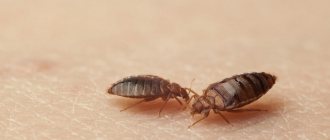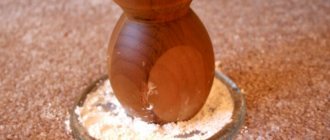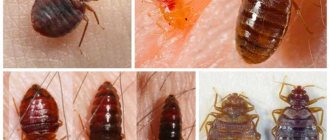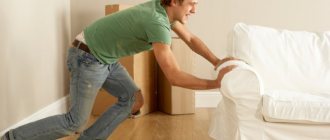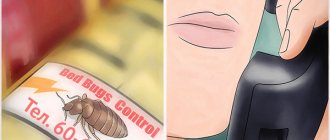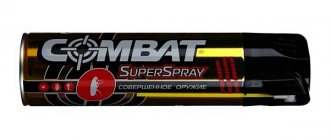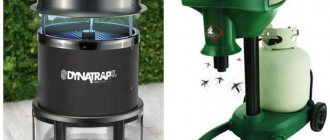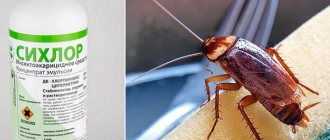Traditional methods are considered a budget-friendly and simple way to remove bedbugs. But is this really so? What are bedbugs afraid of and what means can be used to combat them in order to achieve at least some result?
Carefully!
90% of folk remedies are substances that are used in the fight against bedbugs for purposes other than their intended purpose. This means that when using them for pest control purposes, you alone are responsible for the results and side effects they may have on you, your home and those living with you.
Are bedbugs afraid of light?
It is believed that bedbugs are repelled by light. Indeed, if you wake up at night and turn on the lamp, insects try to hide behind something. This is why people think that leaving a light on all night will stop them from biting. They leave the lamp on for 1, 2, 3 days - no new bites appear. But then the bugs crawl out of their hiding places and attack with renewed vigor.
Constantly switched on light changes the habitual way of life of parasites. They are used to being active in the dark, so they wait for its onset for several days. All this time they remain hungry. When hunger becomes too severe, they have to leave their shelters to avoid dying. The result is complete adaptation of insects to light. Therefore, it is effective against them only for a short time.
Removing bedbugs using an ultraviolet lamp
Ultraviolet and quartz lamps are used in medicine to disinfect premises. They emit ultraviolet light in the frequency range that is capable of resolving the DNA of microorganisms. Such radiation is also harmful to humans. It causes dry skin and leads to premature aging. High-intensity light can cause retinal burns.
If ultraviolet radiation is harmful even to humans, are bedbugs afraid of ultraviolet lamps? Yes, their eyes are very sensitive to light, which can blind them. But vision is secondary for parasites. They spend most of their time in the dark and navigate only by smell. Therefore, briefly turning on an ultraviolet or quartz lamp will not bring the desired effect.
In order for ultraviolet light to kill a bug, it must be exposed to light for 4–5 days. Then the light will cause dehydration and death of the insect. You can’t keep the lamp on for that long at home. A person will receive more harm from it than from the bite of a bed parasite.
Powder that bedbugs are afraid of
ECOKILLER is a natural insecticide based on diatomite. It is sold in bottles with a long and narrow dispenser tube. With its help, you can pour the powder into all places where bedbugs can hide: behind the baseboard, sofa, bed mattress and small crevices. After a day, the house needs to be wet cleaned. If parasites are detected, the procedure is repeated.
How does Ecokiller work?
Here are the advantages of ECOKILLER:
- The product has no odor.
- Diatomite is not addictive to insects.
- The powder is safe for humans and animals. It is often used to produce dietary supplements and vitamin-mineral complexes.
- The product is used sparingly. For processing an apartment of 50 square meters. one bottle of 500 ml is enough. You can order it here.
The fight against bedbugs requires urgent measures. Parasites can be removed using different methods. But those products that harm bedbugs are also dangerous for humans. Therefore, they cannot be used in a home with children. In this case, it is better to use an alternative and no less effective method, which is to treat the home with diatomaceous earth powder. After contact with it, bedbugs will die within 7–9 days.
- Ecokiller bed bug repellent 150 ml.
₽ 149,00
- Ecokiller for bed bugs 500ml.
₽ 349,00
Possible consequences of bites
Contrary to popular belief, there is not a single case in medicine confirming that bed parasites can transmit infection when bitten. Human pathogens do not survive inside an insect.
The most unpleasant consequence of bedbug bites is an allergic reaction, which in very rare cases can lead to Quincke's edema.
Severe itching and scratching of the bite sites can cause infection with bacteria that enter the open wound.
Children in a heavily infested environment may develop anemia as they become the parasites' preferred prey for blood sucking.
The main consequences of bedbug bites are considered to be nervous disorders due to disruption of night sleep. Their symptoms:
- headache;
- irritability;
- constant fatigue;
- loss of appetite;
- increased anxiety.
Do smells repel bedbugs?
Couch bloodsuckers have a developed sense of smell. They smell a person at a distance of up to 3 meters, and carbon dioxide released during breathing - at a distance of up to 30 m. Therefore, it is believed that treating the home with strong-smelling compounds helps repel bedbugs. Is it so?
Vinegar
Vinegar has a pungent odor. Therefore, it can act as a repellent, but not longer than 6 hours. It should be borne in mind that acetic acid is often diluted with water before use to obtain a solution with a weak concentration. In this form, it will not be able to spoil the furniture and decoration. But then the smell will disappear in half an hour.
To get the desired effect, you will have to treat the apartment with vinegar essence. But concentrated acid not only damages property, its fumes cause burns to the mucous membranes of the eyes and respiratory tract. Therefore, using vinegar against bedbugs is either useless or dangerous.
Tar
It is a resinous product that is obtained by dry distillation of wood. It contains resins, phenol, toluene, cresol, benzene, toluene and other substances. They have a strong odor that penetrates into materials. It is impossible to remove it later, but it can take months to disappear on its own.
Despite the strong smell, tar does not work any better than vinegar. During the first days, parasites can remain in shelters. But when hunger becomes stronger than fear, they will still crawl out and get your blood. But your apartment will smell for a long time.
Bleaching
Bleach is used to bleach fabrics and disinfect premises. It smells strongly and causes a burn upon contact with the outer shells. That's why bedbugs are afraid of her. To remove them from the apartment, you need to wash the floors and other surfaces with water and bleach. To prevent burns, you should work with gloves.
You can also use bleach to control bedbugs. It needs to be scattered in all corners, crevices, and secluded places. It will disrupt the integrity of the bug's shell and lead to the death of the parasite. The price of such a victory is the unbearable smell of chlorine, which can cause poisoning and pulmonary edema.
Attention! Bed bugs are afraid of bleach. But it cannot be used in large quantities at home, because it is no less toxic to humans than to insects.
Flammable substances
If bed bugs appear in a house, people advise treating it with gasoline, diesel fuel or kerosene. The point here is not so much the smell, but the resinous consistency of the liquid fuel. It clogs the sensilla - the respiratory organs on the surface of the bug's body, through which oxygen enters (insects do not have a nose). As a result, the parasites suffocate.
To get rid of bedbugs using gasoline, kerosene or diesel fuel, you need to thoroughly treat all surfaces and crevices in which bloodsuckers can hide. Then they will inevitably touch the fuel while leaving the shelters. The problem is that flammable vapors are highly toxic to humans. Another danger lies in creating a fire hazard - the house can burst into flames from the slightest spark.
Essential oils
It is believed that the use of essential oil is effective against bedbugs. Presumably they are afraid of essential oil:
- nettle;
- rosemary;
- chamomile;
- carnations;
- lavender;
- peppermint;
- tea tree.
Using essential oils in their pure form is dangerous for humans and is ineffective in the fight against bedbugs. In order for them to smell the smell, you need to force the ether to actively evaporate. This can be done by diluting a few drops of oil in vodka. The alcohol contained in it is highly volatile and promotes better evaporation of substances dissolved in it.
You can make your own repellent using essential oils. This is the name of the odorous product that bed bugs are afraid of. To prepare it you will need:
- 60 ml water;
- 30 ml vodka;
- 10 drops of peppermint and lemon (grapefruit) essential oil;
- 8 drops of lavender essential oil;
- 5 drops of geranium oil;
- 3 drops of rosemary, cypress and vanilla oils (can be replaced with patchouli and myrtle oils).
All components must be mixed until smooth and placed in a spray bottle. Homemade repellent should be used daily on living rooms and furniture. The advantages of this product are safety for humans and a pleasant aroma at home. The disadvantages include the low efficiency of the method. Over time, bedbugs will get used to the smell, and it will no longer repel pests.
Attention! Many essential oils are contained in the peel of citrus fruits. You can place them under the sofa, behind the bed, near cracks and other hiding places.
Plants with a pungent odor
Scented plants act like essential oils. Bed bugs do not like the pungent smell of plants such as:
- tansy;
- sagebrush;
- marigold;
- chamomile;
- calamus (root);
- mustard (seeds).
There are several ways to use herbs in the fight against bedbugs. You can lay out sprigs of tansy or wormwood on the floor, put them in a closet with linen, or tuck them into the folds of upholstered furniture. But when they dry, the aroma from them will decrease. It is difficult to pull out branches intact from secluded places - they become fragile, causing them to break and leave behind debris.
Another way to use herbs against house bugs is to prepare decoctions. For 1 liter of water you will need 20–30 g of dry grass, inflorescences, roots or seeds. They are placed in a pan and filled with water, placed on the stove. The herb and inflorescences should be boiled over low heat for 5 minutes, seeds - 10 minutes, roots - at least 20 minutes. Then the broth is cooled, filtered and used as a repellent.
Preparing a repellent based on herbal decoction takes a lot of time. But the method is not highly effective. Another disadvantage is that herbal infusions leave stains that are difficult to wash off on fabrics.
Seasonings
It is popularly believed that bedbugs do not like the smell of bay leaves, vanillin, rosemary and cloves. We have already concluded above that “aromatherapy” in the fight against bedbugs is ineffective, and it gives only temporary results. Therefore, seasonings should be used only in combination with other, more effective methods. They can be placed around the house in whole branches or sprayed with the prepared decoction.
Solvents
Acetone and turpentine also have a strong odor. However, bed bugs are afraid not of the smell of solvents, but of contact with them. They corrode the shells of insects, which leads to their rapid death. Despite the ability to exterminate parasites, the use of acetone and turpentine at home is undesirable because:
- solvents are toxic to humans;
- they dissolve paintwork;
- spoil fabrics and other materials;
- They leave behind a persistent unpleasant odor that does not disappear for a long time.
Tar or laundry soap
You can try to repel bedbugs with a soapy smell. Laundry or tar soap are more suitable for this purpose. They leave lingering odors even after drying. For humans they are harmless and quite tolerable. Another advantage of the method is that the soap film that envelops the bug interferes with its breathing. This can lead to the death of insects. But in order to treat parasites with a soap solution, you will first have to find their nesting sites.
Medicines
Among the medicines used in the fight against bedbugs, ammonia and Vietnamese balm “Zvezdochka” are used. Ammonia quickly dissipates, but the balm not only has a persistent odor, but also irritates the body of the bug upon contact. After all, it represents a high concentration of essential oils. But for processing at home you will need as much balm as you will not find in any pharmacy.
A solution of boric acid is also sometimes used in fighting. It doesn't actually harm bedbugs. They are not afraid even of its smell. The product is mistakenly used against bed bugs because it is effective against cockroaches. But the latter die from ingesting acid, while bedbugs feed only on blood.
Habitats
Bed bugs live in a person's home all year round. It makes no difference to them what the temperature is outside the window. Inside there is always a constant, comfortable temperature of around 22 degrees Celsius, humidity is about 60%, there are plenty of secluded places where you can hide from the sun's rays.
- Insects feed on human blood, so they prefer to build housing closer to the sleeping area. The standard and most common place of residence for bedbugs is a bed, mattress, bed, or sofa.
- In second place are furniture near the bed, decorative items, books, photographs, flower pots, peeled wallpaper, peeling parquet, carpets, baseboards.
- Bed bugs rarely settle in interior items - table lamps, clocks, sockets, household appliances, soft toys, pillows, closets with human clothes. They can live in a pet's crib.
Based on this, we can answer the question of whether bedbugs live in clothes in the affirmative. But this requires some conditions.
On the effectiveness of electronic repellers
In recent years, electronic repellers against all pests have gained wide popularity. They are really effective against rodents, moles, birds and even mosquitoes. But in the case of bedbugs, the devices are useless. Bed bloodsuckers are not afraid of ultrasound, electromagnetic or other radiation, because they do not have sensory organs capable of perceiving it.
How to protect yourself from these insects?
The surest way to avoid getting acquainted with bedbugs is prevention. Let's remember a few simple rules for travelers:
- Once in your hotel room, turn over the bed mattress and carefully inspect the seams . Look for any signs of insects;
- Look into the bedside tables and upholstered furniture near the bed;
- Do not place your suitcase near the bed or walls of the room.
If it does happen that a traveler bug got into clothes lying in a suitcase and settled in the apartment, do not panic, but start a merciless fight with it. You don't want to become food for vampires!
Is it possible to drive away bedbugs by starving them?
Bedbugs need food 2 to 7 times a week. Therefore, some people think that leaving home for 1–2 weeks is enough for the insects to die of starvation. This raises the question: are bedbugs afraid of the lack of a nearby food source?
If the search for food is unsuccessful, the insects fall into torpor. They can live in this state for several months. If, having “awakened” they do not get blood again, death is assured. But how many families are willing to leave home for many months?
Fighting methods
It is quite possible to clean things infested with insects, but you need to do it correctly. In this situation, it would be ineffective to take your clothes out into the light frost or leave.
Important!
Parasites cannot live at extremely low temperatures (air temperatures below -17 degrees are detrimental to them). A slight cold snap will not give a positive result when taking things outside.
People who decide that after leaving the apartment for a month, bloodsuckers will not be able to live without food and will die of hunger are deeply mistaken. Insects are capable of falling into suspended animation - a state when all vital processes slow down. While in it, the bug will live, enduring both hunger and low temperature.
Washing clothes in water, the temperature of which should not be lower than 60 degrees, and heat treatment with a steam generator or iron is one of the main ways to combat parasites. If the product cannot be subjected to such treatment, you should use dry cleaning services or treat the item with an insecticidal agent yourself. A small product can be placed in the freezer or thoroughly vacuumed. It is important to only then treat the garbage bag with a chemical.
Now that you know whether bed bugs can live in your clothes, you can take the necessary steps to avoid adverse consequences.
Are bedbugs afraid of pesticides?
Yes, bed bugs are very afraid of pesticides. But they do not cause fear in them, so they do not have repellent properties. However, upon contact with the insect's body, drugs called insecticides lead to their destruction. Here are the means that can be used to treat residential premises:
- aerosols (Dichlorvos, Combat);
- suspensions (Xulate Micro, Get Total);
- liquid chemistry (Executioner, Karbafos).
The advantage of using insecticides is the high efficiency of treatment. But it must be carried out twice with an interval of 10 days in order to destroy the larvae that have hatched from the eggs by this time, but have not yet reached puberty. Another disadvantage of the chemical is that over time, bedbugs develop resistance to it. Its development can be eliminated only by major treatment of premises, which is carried out by specialized organizations using the hot fog method.
Attention! Insecticides are toxic to humans and animals. Therefore, after using them, you need to leave the apartment with your pets for several hours.
How to deal with detected parasites?
It doesn’t matter so much what happened before if the bugs are already rampant. In case of their unbridledness, it is necessary to undertake the tedious process of completely destroying the parasites.
Of course, the process is not tempting, but sometimes you have to sacrifice manicure and the thickness of your wallet. In order to reduce costs, do not try to immediately involve a sanitary team in this matter. Other people's work is not always of high quality, and they will take as much money for the work as the chickens will not peck.
Nowadays, any strong chemical is sold in a store that sells household chemicals. So what's stopping you from going there and shopping? The best of them are described HERE.
Are bedbugs afraid of high and low temperatures?
Bedbugs need a stable temperature. When it drops to +9 oC, they stop reproducing, and when it drops to negative temperatures, the parasites fall into torpor. Therefore, there is no need to freeze in an unheated apartment in winter - the bloodsuckers will wait until the warmth returns. But you can destroy them with high temperatures. Depending on its size, the death of insects can occur instantly or after some time (see table).
| Temperature | Time from treatment to death of the bug | How to reach this temperature |
| +110 оС | Instantly. | Using a hair dryer. |
| +80 оС | Up to 7 seconds. | Using a steam generator. |
| +60 оС | Up to 10 minutes. | By washing things in a washing machine. |
At home, you can treat cracks and other secluded places with a clothing steamer. If it is missing, replace the device with an iron. As a last resort, use a hair dryer turned on at maximum power. However, hot air is less efficient than steam. Therefore, you need to treat furniture more carefully with a hairdryer.
Attention! SES employees treat the premises with hot fog, which is a concentrated solution of insecticides. It also ensures instant death of bed bugs.
Signs of the presence of insects
The only way to make sure there are no parasites in things is to thoroughly inspect not only them, but also the closet itself. It is better to do this in bright light using a magnifying glass. The presence of insects will be revealed by chitinous membranes shed after molting and egg laying. Also on the shelves of the closet you can find excrement of bloodsuckers in the form of small dark balls. You should especially carefully inspect the internal cracks and corners of furniture, as parasites can also settle in them.
Bed bugs in clothes
When inspecting things, pay special attention to seams, various folds and pockets - that is, those places where insects can hide. Pests do not like to live in fur products, since fur fibers make it difficult for them to move. But pajamas and home suits, as well as bed linen, are favorite places for parasites to settle.
What exactly are bedbugs afraid of?
Here are the means and methods that will definitely harm bedbugs:
- boiling water;
- hot fog;
- use of insecticides.
To combat bedbugs, diatomite is also used - this is a rock consisting of the shells of diatoms. It is ground into powder, the particles of which have abrasive properties. When they land on the bedbug’s body, the waxy coating of the carapace is damaged. The damage increases the evaporation of moisture, which leads to the death of the parasite from dehydration.
Chemicals
Some insecticides are even used to treat wearables and underwear, but their quality must be of the highest quality. This group includes:
- "Get";
- "Lambda Zone";
- "Medilis ziper".
Don't forget to take precautions. Processing is carried out in a safe place, making sure that the substances do not come into contact with food. To prevent poisoning, it is advisable to wear a mask and gloves; they will serve as additional protection.
To eliminate risks, treated wardrobe items will have to be placed in a plastic bag and not used for 7-10 days. Finally, they should be washed thoroughly. And those who want to completely protect themselves will take their shirts and gowns to the dry cleaner, not forgetting to warn the employees about the specifics of the situation.
How do they reproduce?
To understand where bed bugs come from, it's helpful to know what their life cycle is. Every day, a sexually mature female is capable of laying up to 5 eggs. In just a lifetime, she is capable of producing from 250 to 500 new individuals. The insect lives for about 15 months, and the time from egg laying to the appearance of the nymph is 30-40 days. How quickly bedbugs reproduce depends on environmental conditions. In unfavorable conditions, this time can increase to 100 days.
Bedbug and its eggs
Males of these parasites are also bloodsuckers, although they have less appetite than females. Females try to hide their clutches in the folds of furniture fabric or clothing. A new colony forms around the clutch.
Features of parasitism
Can bedbugs live in clothes? The answer is clear - they can. But the likelihood of being bitten decreases if a person sleeps in pajamas. Particularly affected are areas of the body that are not covered with a blanket during the night.
Bloodsuckers bite where blood vessels are located close to the surface of the skin. Most often, itchy marks appear on the legs and arms, back, neck and shoulders. In children, the face may be affected.
The parasite's mouthparts are not designed to pierce clothing. Therefore, if a person rests in pajamas at night, the likelihood that he will be bitten by bloodsuckers is minimal.
More often, those parts of the body that are not covered with a blanket at night are attacked. However, a blanket will not stop a very hungry bug - it will crawl under it and still drink blood.
For punctures, they choose those places on the body where blood vessels are located under the skin. More often, bite marks are found on the following areas of the body:
- neck;
- hands;
- legs;
- back;
- shoulders.
When a person puts on night pajamas, it is as if he is gradually inviting bedbugs to come to him. But as long as a person is awake, they will not bite. This will happen when he falls asleep.
How to prevent it from happening again
After disinfection has been carried out, you want to ensure that unpleasant insects never appear in the apartment again. Competent prevention is impossible without knowing what causes bedbugs to appear in an apartment. Here is a short list of preventive measures to protect your home from being re-infested by bedbugs:
- Thorough inspection of suitcases and other luggage after trips and trips.
- Regular treatment of ventilation hatches with repellents (the main way bedbugs enter an apartment from neighbors), and insecticides of all cracks in the walls.
- Adding insecticides to wallpaper paste will prevent insects from breeding behind the wallpaper.
- Mandatory washing in boiling water of all items brought from places of potential infection.
- Freezing or steaming antique furniture immediately after its acquisition.
The listed methods will prevent bedbugs from returning to your home and will rid you of them forever.
Folk remedies
In addition to using herbs against parasites, folk remedies include several effective recipes from improvised products:
- Mix baking soda and vanillin in equal proportions. Scatter the resulting powder in secluded places, potential locations for bedbugs.
- Combine salt (4-5 tablespoons) with vanilla, in the amount of one dessert spoon. Pour the mixture under sofas, beds, carpets, and behind baseboards. Leave for 2-3 hours, then vacuum. Even after cleaning, the room smells pleasant to humans, but unbearable to insects.
But bedbugs are not at all afraid of garlic, despite its pungent aroma.
